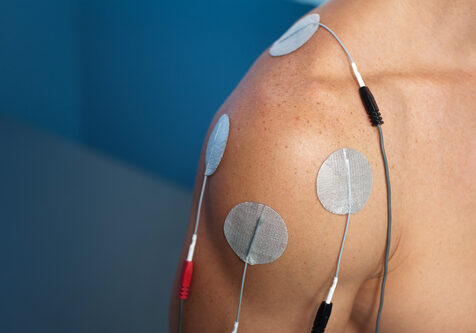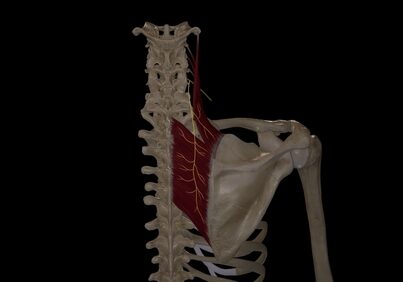Effect of Scapular Proprioceptive Neuromuscular Facilitation on Pain and Disability in Patients with Adhesive Capsulitis
Filed under Uncategorized
Reviewed by Melissa Miller
Mishra, N., Mishra, A., Charaniya, P. (2019). Effect of scapular proprioceptive neuromuscular facilitation on pain and disability in patients with adhesive capsulitis. International Journal of Yogic, Human Movement and Sports Sciences; 4(1): 995-1000
The Skinny
Adhesive capsulitis (AC) is an idiopathic disease that affects the movement of the shoulder. AC is characterized by decreased movement in the glenoid capsule, fibrosis, and decreased range of motion (ROM) in the shoulder with pain. AC has three phases: (1) a painful stage where motion decreases and there is an increase of pain, (2) a frozen stage that includes a loss of motion that can last months to years, and lastly (3) a thawing stage where the range of motion gradually returns. AC can severely impact an individual’s ability to participate in their desired activities throughout the day. When AC advances to phase 2 it can be difficult to gain pain-free ROM. This study assesses the effectiveness of using scapular proprioceptive neuromuscular facilitation (PNF) as an additional strategy in conventional therapy to improve patients’ pain and disability who are in phase 2 of adhesive capsulitis.
In the Weeds
This experimental study used two groups to compare the effectiveness of scapular PNF as an additional strategy in conventional therapy versus conventional therapy on its own to improve patients’ pain and disability. Thirty participants were recruited based on specific criteria. Inclusion criteria included being between the ages of 40-60 years old, having restricted shoulder ROM, and experiencing difficulty with two or more of the following: difficulty with flexion, abduction, external rotation, and/or placing hands behind the body. A limitation was greater than 30 degrees compared to the opposite shoulder and shoulder pain that has persisted for more than 3 months. Participants were excluded if the shoulder pain was due to trauma/injury or other disease processes. Participants were randomly assigned to each group. The experimental group was assigned scapular PNF along with conventional treatment, and the control group was assigned conventional treatment only (pendulum exercises, wand exercise, capsular stretching, hot pack). The scapular PNF techniques used in the study included rhythmic initiation and repeated contraction facilitation. The study was conducted over 6 weeks. Effectiveness was measured by changes in pain using the Visual Analog Scale (VAS), and changes in disability were assessed using the Shoulder Pain and Disability Index (SPADI) Gujarati version. Patients participated in 3 days per week of therapy for 35 minutes each day. Participants took a baseline test for both the VAS and SPADI before starting therapy and again at the end of 6 weeks.
Bringing it Home
Before starting therapy sessions, all participants were equal at baseline according to week 0 VAS and SPADI tests. A paired t-test was used to assess the difference in pre/post-test of both groups. Results found there were significant improvements in pain and level of disability from week 0 to week 6. An independent t-test was further used to compare results between groups. Results demonstrated that the participants in the experimental group, who received the scapular PNF along with the conventional treatment, had significantly greater improvements in the VAS and SPADI tests. The mean difference value of VAS for the experimental group was (3.14±0.3270) while the control group was (2.34±0.3356), and the mean difference value of SPADI in the experimental group was (24.34±2.0637). The control group was (21.14±1.1027). This study demonstrates that scapular PNF can be beneficial to use along with conventional therapy for patients who are in phase 2 of adhesive capsulitis.
Rating (0-5 rating scale): 1 2 3 4 5
This study can be considered a high level of evidence as it was a randomized control trial; however, it had limitations that brought its rating from a 5 to a 3. This study used a small sample size of 30 participants, and there was no blinding in the study. Furthermore, this study only uses two PNF techniques and does not clearly describe what the techniques looked like. Without a clear description of the techniques, it makes clinical application difficult. It is also a limitation that both groups received the same amount of therapy in each session. The experimental group was supposed to have conventional treatment with additional PNF. Still, the experiment’s design made it, so the experimental group was receiving less conventional treatment than the control group. This research demonstrates that the scapular PNF strategies used were beneficial and conventional therapy to improve pain and disability with phase 2 AC patients. However, the limitations in the study decrease it’s overall rating.
More To Read
The Use of Neuromuscular Electrical Stimulation with Upper Extremity Paralysis
The Use of Neuromuscular Electrical Stimulation with Upper Extremity Paralysis By: Mikayla Murphy Martin, R., Johnston, K., & Sadowsky, C. (2012). Neuromuscular electrical stimulation–assisted grasp training and restoration of function in the tetraplegic hand: A case series. The American Journal of Occupational Therapy, 66(4), 471-477. https://doi.org/10.5014/ajot.2012.003004 The Skinny The purpose of the study was to…
Read MoreWhat are the minimally important changes of four commonly used patient-reported outcome measures for 36 hand and wrist condition-treatment combinations
Article Review By: Case Peters Reference Hoogendam, L., Koopman, J.E., van Kooj, Y.E., Feitz, R., Hundepool, C.A., Zhou, C. … The Hand Wrist Study Group (2021) What are the minimally important changes of four commonly used patient-reported outcome measures for 36 hand and wrist condition-treatment combinations. Clinical Orthopaedics and Related Research. epub ahead of print.…
Read MoreDorsal Scapular Nerve Entrapment and Thoracic Pain
Don’t Forget to Evaluate for Dorsal Scapular Nerve Entrapment By Delaney Wright If your patient presents with any upper thoracic pain, it is critical to take measures to evaluate for dorsal scapular nerve entrapment. In a study completed by Sultan et al. (2013), 55 patients with interscapular pain were evaluated clinically and via nerve conduction…
Read MoreSign-up to Get Updates Straight to Your Inbox!
Sign up with us and we will send you regular blog posts on everything hand therapy, notices every time we upload new videos and tutorials, along with handout, protocols, and other useful information.





